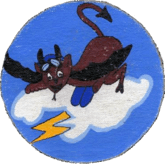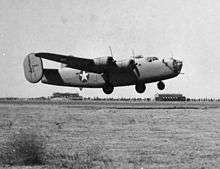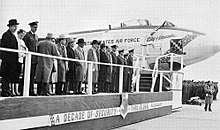415th Flight Test Flight
415th Flight Test Flight
 | |
|---|---|
 A maintenance contractor performs final checks to a 415th Flight Test Flight T-38 Talon prior to taking off from Joint Base San Antonio[note 1] | |
| Active | 3 February 1942 - Present |
| Country |
|
| Branch |
|
| Role | Flight Test |
| Part of |
|
| Garrison/HQ | Randolph Field, Joint Base San Antonio, Texas |
| Decorations |
Distinguished Unit Citation Air Force Outstanding Unit Award[1] |
| Insignia | |
| 415th Flight Test Flight emblem (approved 1 August 1989)[1] |
 |
| Unofficial World War II 415th Bombardment Squadron emblem[2] |
 |
| Aircraft flown | |
| Trainer | Northrop T-38 Talon |
The 415th Flight Test Flight is a United States Air Force reserve squadron. It is assigned to the 413th Flight Test Group of Air Force Reserve Command, stationed at Randolph Field, Joint Base San Antonio, Texas.
The squadron was first activated during World War II as the 25th Reconnaissance Squadron. After redesignation as the 415th Bombardment Squadron, it saw combat in the Mediterranean Theater of Operations, participating in the low level attack on oil refineries near Ploiești, Romania. It earned two Distinguished Unit Citations for its combat operations. After VE Day the squadron returned to the United States and trained with Boeing B-29 Superfortresses until inactivating in Spring 1946.
The squadron was reactivated in 1958 when Strategic Air Command (SAC) reorganized its Boeing B-47 Stratojet wings and placed one third of its bombers on ground alert. It was inactivated in 1962, when SAC's alert status was altered.
In 1994, the squadron was consolidated with the 6515th Test Squadron, which had been performing flight tests on McDonnell Douglas F-15 Eagle aircraft at Edwards Air Force Base, California, since 1989. It was inactivated in 1994, but in 2001 was activated in the reserve to perform flight tests on trainer aircraft.
Mission
The 415th is a small unit, consisting of a handful of test pilots and a cadre of other noncomissioned officers.[3]
The unit performs flight testing for Northrop T-38 Talon jet trainers at Randolph Air Force Base. The unit performs functional check flights, making sure the aircraft are ready to fly after undergoing modifications and repairs.[3]
The flight tests planes repaired or modified by the 571st Aircraft Maintenance Squadron of the 309th Maintenance Wing, which performs T-38 overhauls at Randolph and handles depot maintenance of all T-38s in the Air Force, as well as some Navy T-38s. Planes are given functional check flights before delivery to the field. Flights last about an hour and certify the aircraft for flight. The tests are performed before the planes are returned to operational service. The flight also ferries T-38s between their bases and the repair depot.[3]
History
World War II
![]()
Training in the United States
The squadron was first activated as the 25th Reconnaissance Squadron' at MacDill Field, Florida and attached to the 98th Bombardment Group. The 24th soon moved to Barksdale Field, Louisiana, where it began to train as a Consolidated B-24 Liberator squadron under Third Air Force. In April, it was converted to a heavy bomber unit and redesignated the 415th Bombardment Squadron and was assigned, rather than attached to the 98th Bombardment Group.[1][4]
The squadron's training was short and it deployed to Egypt in July 1942[1] over the South Atlantic Ferrying Route transiting from Morrison Field, Florida, though the Caribbean Sea to Brazil. It made the Atlantic crossing from Brazil to Liberia, then transited east across central Africa to Sudan. The air echelon of the group reformed with the ground echelon which traveled by the SS Pasteur around the Cape of Good Hope, joining with the air echelon of the squadron and the 345th Bombardment Squadron at RAF Ramat David, in Palestine.[5]
Combat in the Middle East

Upon arrival in the Near East, the squadron became part of United States Army Middle East Air Force, which was replaced by Ninth Air Force in November. It entered combat in August, attacking shipping and harbor installations to cut Axis supply lines to North Africa. It also bombed airfields and rail transit lines in Sicily and mainland Italy. The squadron moved forward with Ninth Air Force to airfields in Egypt; Libya and Tunisia supporting the British Eighth Army in the Western Desert Campaign. Its support of this campaign earned the squadron the Distinguished Unit Citation.[1]
On 1 August 1943, the squadron participated in Operation Tidal Wave, the low-level raid on oil refineries near Ploiești, Romania. Alerted to the vulnerability of the Ploiești refineries by a June 1942 raid by the HALPRO project, the area around Ploiești had become one of the most heavily defended targets in Europe.[6] The squadron pressed its attack on the Asta Romana Refinery through smoke and fire from bombing by another group's earlier attack and heavy flak defenses. The squadron's actions in this engagement earned it a second Distinguished Unit Citation.[1]
When the forces driving East from Egypt and Libya met up with those moving westward from Algeria and Morocco in Tunisia in September 1943, Ninth Air Force was transferred to England to become the tactical air force for the invasion of the European Continent.[7] The squadron, along with all Army Air Forces units in North Africa became part of Twelfth Air Force. In November 1943, the squadron moved to Brindisi Airport, Italy, where it became part of Fifteenth Air Force, which assumed control of strategic operations in the Mediterranean Theater of Operations, while Twelfth became a tactical air force.[4][8]
Strategic operations in Italy
The squadron continued strategic bombardment raids on targets in Occupied France, southern Germany, Czechoslovakia, Hungary, Austria and targets in the Balkans. These included industrial sites, airfields, harbors and lines of communication. Although focusing on strategic bombing, the squadron was sometimes diverted to tactical operations, supporting Operation Shingle, the landings at Anzio and the Battle of Monte Cassino. In the summer of 1944, the squadron supported Operation Dragoon, the invasion of southern France.[4][9] The unit also assisted the Soviet advance into the Balkans,[4] and supported Yugoslav Partisans and guerillas in neighboring countries.
Return to the United States
The squadron returned to the United States in May 1945. Upon arrival it was redesignated as a very heavy Boeing B-29 Superfortress squadron and began training for deployment to the Pacific to conduct strategic bombardment raids on Japan. However, very heavy bomber groups were organized with three squadrons, rather than the four of the 98th Group, so in July 1945, the squadron was inactivated and its personnel and equipment were transferred to the other squadrons of the 98th Group.[1][10]
Strategic Air Command

From 1958, the Boeing B-47 Stratojet wings of Strategic Air Command (SAC) began to assume an alert posture at their home bases, reducing the amount of time spent on alert at overseas bases. The SAC alert cycle divided itself into four parts: planning, flying, alert and rest to meet General Thomas S. Power’s initial goal of maintaining one third of SAC’s planes on fifteen minute ground alert, fully fueled and ready for combat to reduce vulnerability to a Soviet missile strike.[11] To implement this new system B-47 wings reorganized from three to four squadrons.[11][12] The 415th was activated at Lincoln Air Force Base as the fourth squadron of the 98th Bombardment Wing.[1] The alert commitment was increased to half the wing's aircraft in 1962 and the four squadron pattern no longer met the alert cycle commitment, so the squadron was inactivated on 1 January 1962.[1]
Flight test
Testing modifications for Air Force Systems Command
The second predecessor of the flight was activated in March 1989 by Air Force Systems Command at Edwards Air Force Base, California, as the 6515th Test Squadron and assigned to the 6510th Test Wing. The squadron assumed the McDonnell Douglas F-15 Eagle testing mission, evaluating modifications prior to them being implemented for operational aircraft. In 1992, as the Air Force eliminated MAJCON (four-digit) units, the 6515th was consolidated with the 415th as the 415th Test Squadron The squadron was inactivated in 1994[1] and its testing mission was assumed by the 419th Flight Test Squadron.
Functional testing for Air Force Reserve Command
The squadron was reactivated as the 415th Flight Test Flight in 2001 as a Northrop T-38 Talon functional check flight organization at Randolph Air Force Base.[1] The squadron participates in a program designed to extend the service life of the Air Force's fleet of T-38C Talon aircraft through the year 2020. In addition to modifying the propulsion system, the program also involves an upgrade to the plane's avionics. This upgrade is designed to improve the training capabilities of the T-38 and provide one configuration for all training roles. Once completed, the program will make it easier for pilot trainees to transition from the T-38 to a front-line fighter or bomber aircraft.[13]
Air Education and Training Command is the lead command responsible for sustainment and modernization of T-38s in the Air Force inventory. The T-38 System Program Office at the Ogden Air Logistics Center at Hill Air Force Base, Utah, provides primary field support for the aircraft and has operational control of the 415th's mission, while Air Force Reserve Command maintains administrative control of the unit.[13]
Lineage
415th Bombardment Squadron
- Constituted as the 25th Reconnaissance Squadron (Heavy) on 28 January 1942.
- Activated on 3 February 1942
- Redesignated 415th Bombardment Squadron (Heavy) on 22 April 1942
- Redesignated 415th Bombardment Squadron, Heavy on 1 July 1943
- Inactivated on 3 July 1945
- Redesignated 415th Bombardment Squadron, Medium on 11 August 1958
- Activated on 1 September 1958
- Inactivated and discontinued on 1 January 1962
- Consolidated with the 6515th Test Squadron as the 6515th Test Squadron on 1 October 1992[1]
415th Flight Test Flight
- Designated as the 6515th Test Squadron and activated on 10 March 1989
- Consolidated with the 415th Bombardment Squadron on 1 October 1992
- Redesignated 415th Test Squadron on 2 October 1992
- Redesignated 415th Flight Test Squadron on 1 March 1994
- Inactivated 1 October 1994
- Redesignated 415th Flight Test Flight on 24 September 2001
- Activated in the Reserve on 1 October 2001[1]
Assignments
- 98th Bombardment Group, 3 February 1942 – 3 July 1945
- 98th Bombardment Wing, 1 September 1958 – 1 January 1962
- 6510th Test Wing (later 412th Test Wing), 10 March 1989
- 412th Operations Group, 1 October 1993 – 1 October 1994
- 622d Flight Test Group, 1 October 2001
- 413th Flight Test Group, 1 October 2003 – present[1]
Stations
|
|
Aircraft
See also
References
- Notes
- ↑ Aircraft is Northrop T-38-65-NO Talon serial 66-8367, piloted by the flight commander.
- ↑ Aircraft is Consolidated B-24D-45-CO Liberator serial 42-40322 "Cornhusker". This plane was shot down over the Ionian Sea by Me109s from IV/JG 27 while returning from the 1 August 1943 low-level mission to Ploiești, Romania. All 10 crew members were KIA. MACR 178. Photo taken at Tobruk or Benina Airfield, Libya.
- Citations
- 1 2 3 4 5 6 7 8 9 10 11 12 13 14 15 16 Haulman, Daniel L. (March 19, 2015). "Factsheet 415 Flight Test Flight (AFRC)". Air Force Historical Research Agency. Archived from the original on September 29, 2015. Retrieved May 24, 2017.
- ↑ See Maurer, Combat Squadrons, p. 508 (no approved emblem prior to 1963)
- 1 2 3 4 Goetz, Robert (July 6, 2012). "Randolph reservists ensure health of T-38 fleet". Joint Base San Antonio Public Affairs. Archived from the original on April 2, 2015. Retrieved May 25, 2017.
- 1 2 3 4 Maurer, Combat Units, pp. 169-170
- ↑ Rogers, pp. 77-78
- ↑ Schultz, pp.64-65
- ↑ Maurer, Combat Units, p. 464
- ↑ Maurer, Combat Units, pp. 467, 470
- ↑ Dorr, B-24 Liberator Units
- ↑ Dorr, B-29 Superfortress Units
- 1 2 Schake, p. 220 (note 43)
- ↑ "Abstract (Unclassified), History of the Strategic Bomber since 1945 (Top Secret, downgraded to Secret)". Air Force History Index. 1 April 1975. Retrieved March 4, 2014.
- 1 2 Patterson, Lt (2003). "A longer life: reserve test flight has big role in T-38 upgrade program". The Free Library by Farlex. Retrieved May 25, 2017.
Bibliography
![]()
- Deaile, Melvin G. (2007). The SAC Mentality: The Origins of Organizational Culture in Strategic Air Command 1946-1962. Chapel Hill, NC: University of North Carolina. Retrieved February 14, 2015.
- Dorr, Robert F. (2000). B-24 Liberator Units of the Fifteenth Air Force. Combat Aircraft. 21. Botley, UK: Osprey Publishing. ISBN 1-84176-081-1.
- Dorr, Robert F. (2002). B-29 Superfortress Units in World War Two. Combat Aircraft. 33. Botley, UK: Osprey Publishing. ISBN 1-84176-285-7.
- Maurer, Maurer, ed. (1983) [1961]. Air Force Combat Units of World War II (PDF) (reprint ed.). Washington, DC: Office of Air Force History. ISBN 0-912799-02-1. LCCN 61060979.
- Maurer, Maurer, ed. (1982) [1969]. Combat Squadrons of the Air Force, World War II (PDF) (reprint ed.). Washington, DC: Office of Air Force History. ISBN 0-405-12194-6. LCCN 70605402. OCLC 72556.
- Ravenstein, Charles A. (1984). Air Force Combat Wings, Lineage & Honors Histories 1947-1977 (PDF). Washington, DC: Office of Air Force History. ISBN 0-912799-12-9. Retrieved December 17, 2016.
- Rogers, Edith (June 1945). "The AAF in the Middle East: A Study of the Origins of the Ninth Air Force, USAF Historical Study No. 108" (PDF). Assistant Chief of Air Staff Intelligence, Historical Division. Retrieved May 25, 2017.
- Schake, Col Kurt W. (1998). Strategic Frontier: American Bomber Bases Overseas, 1950-1960 (PDF). Trondheim, Norway: Norwegian University of Science and Technology. ISBN 978-8277650241. Retrieved July 27, 2015.
- Schultz, Duane (2008). Into the Fire: Ploesti, the Most Fateful Battle of World War II. Yardley, PA: Westholme Publishing. ISBN 978-1594160776.
